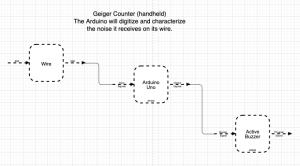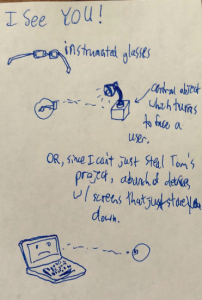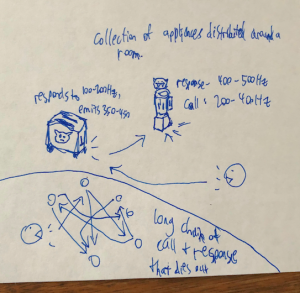So, I was thinking about flow, right? I heard we needed an illustration, narrative description, materials list, and a flow diagram for each of three unique, world-shattering projects. Here’s what I came up with:
- Geiger Counter for emitted electromagnetic signals
- I SEE YOU ALL THE TIME – A reminder that cameras and sensors in all devices can be on all the time without you knowing
- Electronic Jungle – Call & Response from a distributed set of everyday devices
EMI Geiger Counter
In the 1800s when people began seriously exploring electricity, they did all kinds of fun experiments for people to try out this brand new phenomena. People were found to exhibit extended trembling in response to a single shock, or feel extreme sickness while holding a voltage of 1V across their body. Many people would hold hands in a big circle and get shocked together by one of these demonstrations. Lovers would split off for 10 minutes, with the girl sitting in a big, floating electrical cage. When the boy kissed her, a spark would fly across as their lips touched. Electricity was IN!
However, many scientists at the time did studies that had *shocking* results. A bin of blood was found to clot slower in response to a slight voltage. Galvani, inventor of the galvanic pile, found his ears ringing, tongue tasting metal, and hearing sounds that weren’t there after shocking himself with up to 300V from large stacks of copper, zinc, and salt water-soaked paper. Certain people were found to have responses to just being near electricity. Much of the effects are mentioned (and cited!) in the book “The Invisible Rainbow: A History of Electricity and Life” by Arthur Firstenberg.
Our buildings today are swamped with electromagnetic radiation, which comes from any electronic device: WiFi, Bluetooth, power adaptors, wall power plugs, laptops, earbuds, toasters, smart home devices. We are sitting in a thick soup of photons carrying information, and we can’t get enough of it. Experts create standards today for maximum exposure levels to electrical and magnetic fields; you may have heard things like “conforms to IEEE standards … Research have found no deleterious effects from long-term exposure to magnetic and electric fields.” But do you know that? How is it possible that high-energy particles and the electromagnetic fields produced by them cannot influence our brain and other organ function, when those organs are controlled by tiny, delicate electrical nerves?
EMI Geiger Counter explores the possibility of electricity exposure being dangerous by using a classically dangerous phenomena and its corresponding detector: radiation and the Geiger counter. The Geiger counter is a tube which responds to radiation by emitting a pulse. Usually this pulse is fed into a speaker, which makes a characteristic clicking noise that increases in rate as radiation levels increase.

Emitted electromagnetic noise is called electromagnetic interference (EMI). This project will create a handheld, remote-shaped box which holds an EMI detector, “exposure meter”, and safety LEDs for quick checking. A speaker in the device will click at a rate that responds to the total electronic noise level. The device will be placed in on a table with a multitude of everyday electronics like toasters, smarthomes, microwaves, and phones, and the user will feel free to explore the invisible energy that each emits.
This project is interesting because it illustrates the invisible energy that is fundamental to most modern technology, and makes people think about the possibility of its danger in an exploratory environment. In all truth, electricity could be subtly bad for us but just not addressed because of the value it provides for the people who profit from the technology it enables. Remember those cigarette manufacturers?
I love to think about topics that mainstream science considers “settled.” Since this is just a handheld piece, I’d want to put in a lot more effect in the physical construction than the electronic, which is a good change of direction for me.
The devices in question actually do emit plenty of electromagnetic interference, so I don’t need to instrument any of the props. Materials would include:
- borrowed list of appliances
- a voltmeter (for the dial)
- speaker for the clicking
- Arduino for controlling everything
- battery
- switch for turning off the clicking
- A few LEDs.

The Arduino can do all the math.
I SEE YOU ALL THE TIME
Did you know that Facebook recently got caught turning on its users’ device camera and microphones while people were just scrolling through their Instagram feeds? The frequency at which this happens has gotten to the point where it is not reported or notable anymore. This project aims to remind users that their devices can be hacked into by malicious actors and the camera/microphones can be turned on, but also that their devices can be harnessed maliciously by neutral actors like software companies.
The setup is again a set of appliances and daily electronic devices. There will be a monitoring screen which shows the live heartrate, location, schedule, window open on computer, song listening to on Spotify, and photo of the device webcam of the user. The effect of being watched but more than just seen is what I want to go for.

The user will wear a set of glasses which knows when they look at a specific device. That device will then respond to their “input” of attention, like the laptop will show a face, a lamp will turn on and face you, and a smart home could light up. These responses to user attention are things we might even buy for our own homes if it makes our lives more convenient, but I want to show people how weird it is by defamiliarizing our usual input devices and configuring them to show a different output. Attentional input is invisible, which makes it such a good control interface, but it is also always-on and invasive to our houses.
Materials:
- Set of appliances
- Sunglasses
- IR receiver and emitter
- Tiny Bluetooth emitters


Electric Jungle
Maya Lin once did this piece where animal noises were played over speakers in a room. These were “jungles”, which had a cacophony of noises from birds, from trees, from animals large and small, from geckos and ants and everything else. But as you stayed longer and longer in the room, the noises would begin to die off. No longer would you hear the cockatoo, or the birds-of-paradise, or the grunting animals. And this was meant to show extinction, a gradual loss of variety of life due to our ignorant and destructive behavior.
We live in a dense jungle ecosystem today, which exhibits similar characteristics. As IoT spreads, each device can access the internet and therefore talk to one another. We don’t see this happening because the flow is invisible, but they share a common link. Further, users do not consider that their devices can talk to each other about the user. Not in a gossipy way, but rather to do information consolidation. The way they do this resembles being in an invisible jungle, where the animals/devices are constantly in contact through sound and proximity.
Electric Jungle will expose the communications of all our devices talking to each other, and even allow users to input into the environment. Each device will have a specific “call” they respond to, when the power level of a certain set of frequencies goes above a threshold. When the device gets its own call, it will emit its “response,” a sound + light + etc. output, which has the potential to trigger another device’s “call”. And so the chorus will continue, with device talking to device with us in the middle of it.
These devices will be scattered across different regions of the room, and will create an atmosphere of the jungle. But more than that, the users will be able to input to the devices as well. By whistling or yelling, users can trigger the device’s calls using their own voices and sounds, and enter into the jungle which we spend so many of our hours in.

I thought of this while trying to illustrate the delay caused by the speed of sound, but I thought it’d be much cooler to create an environment with all these listeners and responders. Like a real jungle, but one that we’ve made ourselves. I am looking forward to the many types of experiences people can have with this, in the different noises they can make and calls they can respond to. It will be pretty fun to use.
Materials:
- Speaker with tone control
- Microphones
- LEDs
- Arduinos
- Some appliances
